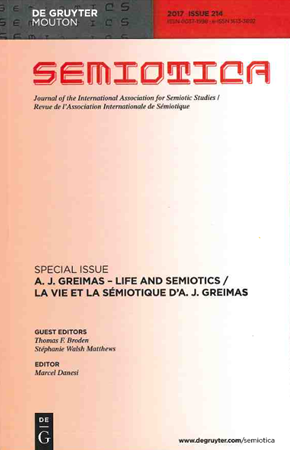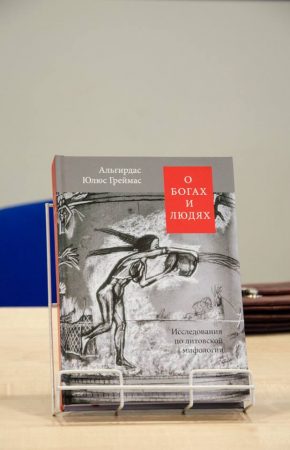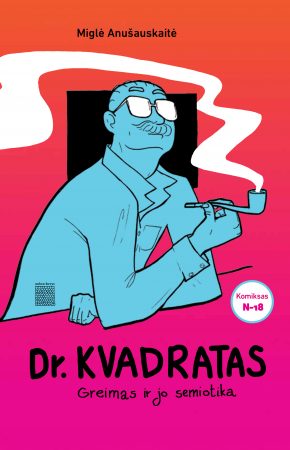PUBLICATIONS
☐
The commemoration of Greimas’ centenary would not be complete without the works dedicated to his personality and ideas, as well as without translations of his own works into different languages. On this page, we present publications of the year of Greimas.
☐
New issue of Semiotica 214 (Feb. 2017): A. J. Greimas: Life and Semiotics / La vie et la sémiotique d’A. J. Greimas
☐
New issue of Semiotica 214 (Feb. 2017): A. J. Greimas: Life and Semiotics / La vie et la sémiotique d’A. J. Greimas, edited by Thomas F. Broden and Stéphanie Walsh Matthews, XIV & 438 p. Hard copy and electronic versions published in February 2017.
Semiotica is marking the centennial of the birth of A. J. Greimas (1917–1992) with a pair of special bilingual issues honoring the semiotician. The first project focuses on his own work, while the second, Semiotics Post-Greimas / La Sémiotique Post-Greimassienne, offers essays that develop the impetus of his ideas in today’s changing context. Taken together, the collected articles testify to Greimas’s conception of semiotics as a challenging intellectual adventure whose transdisciplinary perspectives can inform thinking in diverse arts and fields of inquiry. The research reflects his dedication to building semiotics as a long-term collective enterprise conjoining theory and practice, combining epistemological reflection and applied research. Bringing together contributors from four continents and thirteen countries, the two issues include collaborators and fellow travelers of Greimas, young colleagues who extend and transform his project, and scholars working from a host of other perspectives. The texts also communicate Greimas’s semiotic inspiration in a broader sense by calling attention to his influential research in linguistics, lexicography, lexicology, and comparative mythology.
On Meaning in Exile: Lithuanian Chronicles
☐
Algirdas Julien Greimas, On Meaning in Exile: Lithuanian Chronicles. Texts translated from Lithuanian to French by Lina Perkauskytė, selected by Saulius Žukas and Kęstutis Nastopka, with forewords by Ivan Darrault-Harris and Denis Bertrand. Limoges: Lambert-Lucas, 2017.
Algirdas Julien Greimas. The Person and the Ideas, vol. I
☐
Algirdas Julien Greimas. The Person and the Ideas, vol. I, edited by Arūnas Sverdiolas, Vilnius: Baltos lankos, 2017
The first volume of Algirdas Julien Greimas. The Person and the Ideas serves as an introduction to the person of Algirdas Julien Greimas (1917-1992) – semiotician, mythologist, linguist, literary and cultural critic. This volume comprises Greimas’ autobiographic writings and selected letters to a number of people, interviews, a batch of photos, reminiscences of people who were in touch with him, as well as biographic texts. Most of the material is being presented to the Lithuanian reader for the first time.
Of Gods and Men. Studies in Lithuanian Mythology
☐
Algirdas Julien Greimas, Of Gods and Men. Studies in Lithuanian Mythology. Translated from Lithuanian to Russian by Marija Čepaitytė. Moscow: Neolit, Vilnius: Baltos lankos, 2017
It was the Russian philologist and publisher Yevgeny Permyakov who had the idea to translate Algirdas Julien Greimas’ Of Gods and Men into Russian. Marija Čepaitytė undertook the task of translation. After Permyakov’s tragic death, the project remained unfinished. With the centenary of Greimas’ birth approaching, Marija Čepaitytė resumed and completed the translation with the help of Tomas Čepaitis and the support of the Lithuanian Council for Culture and the Embassy of the Republic of Lithuania in the Russian Federation. The translation has been proofread by doctor of philology Marya Zavyalova. A comprehensive opening article, “Algirdas Julien Greimas and his Mythology”, has been provided by Kęstutis Nastopka. The book is complemented by Petras Repšys’ sketches made for his Seasons frescoes.
A. J. Greimas – a life in semiotics
☐
“A. J. Greimas – a life in semiotics“, of the “Sign Systems Studies” journal, published by the Department of Semiotics at the University of Tartu. The issue was edited by Andrius Grigorjevas, Remo Gramigna and Silvi Salupere. The authors featured are Franciscu Sedda, Eero Tarasti, Jacques Fontanille, Massimo Leone, Paolo Bertetti, Thomas F. Broden, Dalia Satkauskytė, Dmitrij Gluščevskij, Gintautė Žemaitytė, Herman Tamminen, Tatjana Pilipoveca, Kalevi Kull. You can find the online version here: http://www.sss.ut.ee/index.php/sss/index
Dr Quadratus
☐
Miglė Anušauskaitė, Dr Quadratus, Vilnius: Aukso žuvys, 2017
The comic tells the story of one person’s life: from Algirdas Julien Greimas’ childhood in Kupiškis to his studies in Kaunas, through the horrors of World War II, through Alexandria to France. The author playfully injects semiotic theory, philosophical currents, and advice on how to appear smarter into the graphic narrative. It is a very important and, most importantly, interesting story intended for readers of any age!
Maupassant: the Semiotics of Text: Practical Exercices
☐
Algirdas Julien Greimas, Maupassant: the Semiotics of Text: Practical Exercices, translated from French to Lithuanian by Kęstutis Nastopka and Saulius Žukas, Vilnius, 2017
The translation of the study Maupassant by Algirdas Julien Greimas has been undertaken by Saulius Žukas a couple of decades ago. Translated fragments were discussed in detail at the theoretical seminar of the A. J. Greimas Centre of Semiotics, and thus stuck in the memory of soon-to-be literary scholars. Having translated six of the study’s sequences, some time later Saulius Žukas asked me to finish the job. While the manuscript of the translation rested, the theoretical horizon and terminology of Lithuanian semiotics expanded significantly. I adapted the manuscript of the earlier translation to the contemporary semiotic parlance.
According to Greimas, the author of the short story is using a bow with several strings. Various isotopies overlap, recurrent figures cover up digressions of thought. Choosing Maupassant’s short story as a “slightly outdated” text, undistorted by modern interpretations, Greimas hoped that the models of analysis offered here could be applied to various literary discourses and even stereotypical human behavior. The reader of this study will get a chance to take part in a spectacular journey of analytic thinking.
Kęstutis Nastopka









